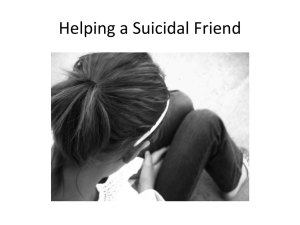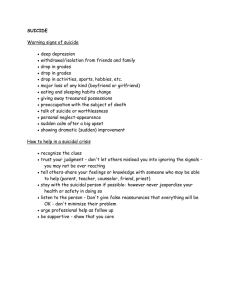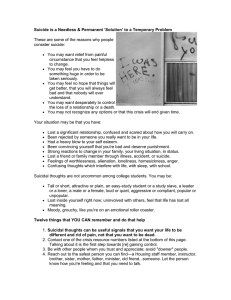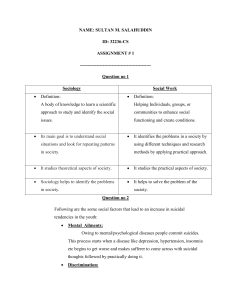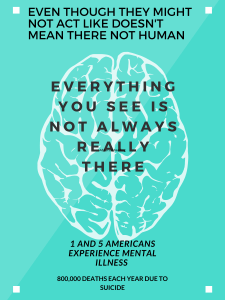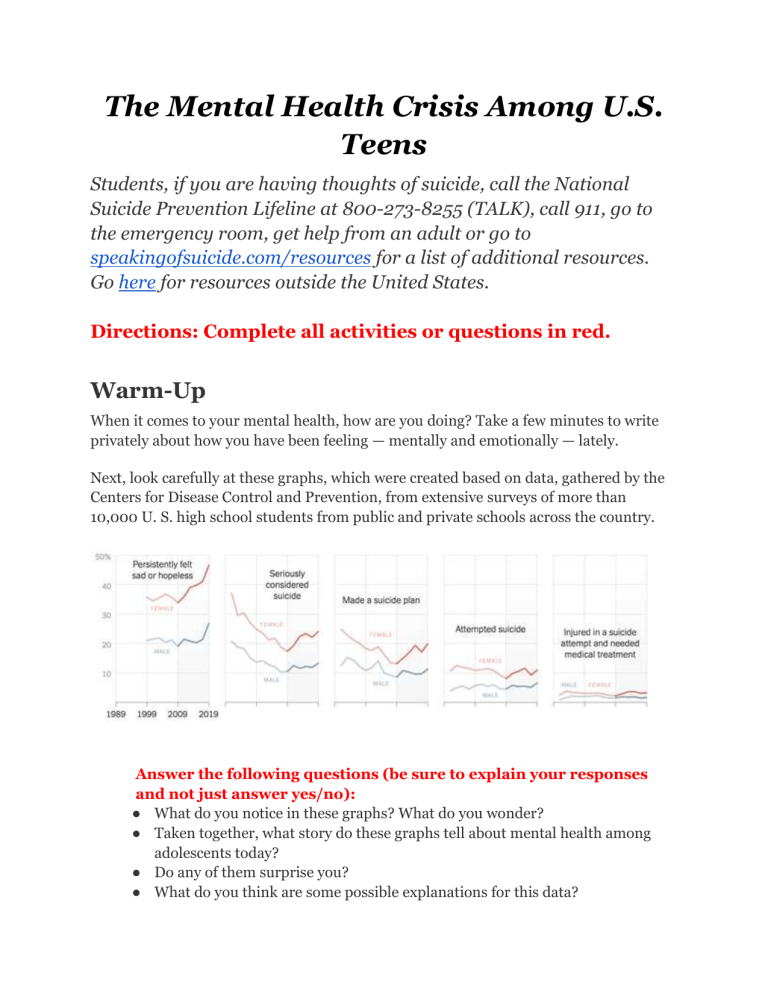
The Mental Health Crisis Among U.S. Teens Students, if you are having thoughts of suicide, call the National Suicide Prevention Lifeline at 800-273-8255 (TALK), call 911, go to the emergency room, get help from an adult or go to speakingofsuicide.com/resources for a list of additional resources. Go here for resources outside the United States. Directions: Complete all activities or questions in red. Warm-Up When it comes to your mental health, how are you doing? Take a few minutes to write privately about how you have been feeling — mentally and emotionally — lately. Next, look carefully at these graphs, which were created based on data, gathered by the Centers for Disease Control and Prevention, from extensive surveys of more than 10,000 U. S. high school students from public and private schools across the country. Answer the following questions (be sure to explain your responses and not just answer yes/no): ● What do you notice in these graphs? What do you wonder? ● Taken together, what story do these graphs tell about mental health among adolescents today? ● Do any of them surprise you? ● What do you think are some possible explanations for this data? Read the article: https://www.nytimes.com/2022/04/23/health/mental-healthcrisis-teens.html?smid=url-share After reading the article, pick 4 of the 9 questions below to answer. Section 1: Introduction 1. The article says, “In December, in a rare public advisory, the U.S. surgeon general warned of a ‘devastating’ mental health crisis among adolescents.” What are two pieces of evidence in the introduction that demonstrate that mental health among adolescents is a national crisis? Do you agree with this assessment? 2. What questions does this decline in mental health raise for you? Section 2: ‘A typical outpatient’ 3. The age of puberty onset has dropped markedly over the last century. How might this shift be contributing to the adolescent mental health crisis, according to experts? 4. What are at least four ways adolescence is different today than in past generations? How do experts explain these changes? What do you think are some possible explanations? What questions do you have? Section 3: ‘A virtual crush’ and ‘Elaniv’ 5. Emily Pluhar, a child and adolescent psychologist at Harvard, said that “the challenge and the progress” of modern adolescence “is there are so many types of identity.” In what ways might having so many choices be progress? In what ways might it be a challenge? 6. The article says, “Health experts note that, for all its weight, the adolescent crisis at least is unfolding in a more accepting environment.” Do you agree that people today are more accepting of mental health challenges? Give an example from the article, or from your own experience, to support your opinion. 7. Experts say a rise in loneliness is a key factor of declining mental health. Why do you think teenagers today are lonely? Do you agree with Bonnie Nagel, a psychologist at the Oregon Health & Science University, who believes that social media is part of the problem? Section 4: ‘The pandemic factor’ and ‘Into the forest’ 8. The article tells the story of the mental health crisis through M, a 13-year-old who has experienced severe depression, self-harm and a suicide attempt. Why do you think the author chose to write the article this way? How does M’s story help us better understand what young people today are going through as well as what might help them? Do you relate to any part of M’s experience? 9. Media Literacy: At the end of the article, there is a note about how the reporter, Mr. Richtel, spoke with adolescents and parents for this series. Why did he approach this story differently than he might have other stories? Do you think The Times made the right choice in granting these young people anonymity, given the paper’s high bar for that? Suicide Among Teens FACTS ON SUICIDE ● ● ● Teenage suicide is preventable. When a person is depressed, they are NOT thinking, feeling, or acting the way they normally do. We must get them help, to get them back on track. We must learn what the warning signs are and who is at higher risk. Among young people aged 15-24, suicide is the 3rd leading cause of death, behind accidents and homicide. The number has tripled in recent years. Every day in the U.S., approximately 14 young people between the ages of 15-24 die at MYTHS OF SUICIDE ● ● ● ● ● Teenagers who talk about attempting suicide are doing it for attention. True, and they NEED the attention. There is something going on that's causing them to feel this way. They need people to listen, and professionals to help them. All teenagers who are suicidal are depressed. This statement is true, but the reverse is not true, most people will experience times in their lives when they are depressed, but have no suicidal ideation. Suicidal people really want to die, so there's no way to stop them. False. They are depressed and need help. With help, they can feel better and find other solutions. Talking about suicide will cause a student to attempt suicide. False. It's just the opposite: not talking about it could escalate the problem. Even thinking about it makes the suicidal person feel worse. Talking will help bring understanding. Talking about it can relieve suicidal students and get them the help that's needed. Discussing the subject openly shows that you take the person seriously and that you care. If a person really wants to kill himself or herself, no one has the right to stop him or her. ● ● ● False. We would help a person who was physically sick or injured; we need to help a person who is mentally ill. Once a person is suicidal, they're suicidal forever. False. Teens who are suicidal can go on to lead useful lives, once they get help. Usually the suicidal feelings are for a limited period of time. Improvement following a suicidal crisis means that the suicide risk is over. False. Most suicides occur within 3 months following the beginning of "improvement", when the teen has the energy to put their morbid thoughts and feelings into effect. Relatives and physicians should be especially vigilant during this period. their own hands. That's one suicide every 1 hour and 40 minutes. WARNING SIGNS OF SUICIDE ● ● ● ● ● ● ● ● A recent suicide in the family or friend. Teens are especially vulnerable when a close family member or friend commits suicide. The grieving process and depression can interrupt normal thought processes. Trouble coping with recent losses, death, divorce, moving, break-ups, etc. Experience with a traumatic event. Sometimes a significant traumatic event can create feelings of hopelessness and despair. Making final arrangements, such as writing a will or eulogy, or taking care of details (i.e. closing a bank account). Gathering of lethal weapons (purchasing weapons, collecting pills, etc.). Giving away prized possessions such as clothes, CD's, sports equipment, treasured jewelry, etc. Preoccupation with death, such as death and/or 'dark' themes in writing, art, music lyrics, etc. Note that today's music has more of this and is not necessarily related to suicidal feelings. Sudden changes in personality or attitude, appearance, chemical use, or school behavior. VERBAL SIGNS OF SUICIDE ● ● ● ● ● ● ● "I can't go on anymore" "I wish I was never born" "I wish I were dead" "I won't need this anymore" "My parents won't have to worry about me anymore" "Everyone would be better off if I was dead" "Life sucks. Nobody cares if I live or die" STUDENTS WHO ARE AT HIGHER RISK ● ● ● ● ● ● ● ● ● ● Teenagers who have attempted suicide previously, especially if problems and other recurring concerns were not completely resolved Teenagers with little self-esteem Teenagers in trouble with the law Teenagers who are suffering from depression Teenagers who have been abused, molested, or neglected Teenagers who abuse drugs and/or alcohol Teenagers who are perfectionists Teenagers who are struggling with sexual orientation (gays and lesbians) Teenagers who are in dysfunctional families Teenagers who fail in school-potential dropouts What’s Going On? For each of the following scenarios, determine if the individual is at risk, the warning signs, and the verbal warnings. Use the lists from above. Scenario LATOSHA'S STORY Latosha was a 15-year-old girl who lived in the Midwest. Her parents had recently divorced, which forced her to move to a new community of 3,000 people. She hated the small town atmosphere, and didn't make any new friends. Her sister Tiffany, her 'only' friend, was going away to college in the fall, which made her feel even worse. Latosha was having trouble sleeping, her grades were falling, and At Risks (refer to Warning Signs the list of risks and determine if any are present) ● Her sister her only Teenagers friend was leaving her who are suffering from depression Verbal Warnings She said she cried every day she was crying almost everyday. She tried to tell her dad and new stepmom that she was feeling terrible, but they said that things would get better if she would just give it some time. She gave her sister her birthstone ring, and said she wouldn't need it anymore. HALEY'S STORY Haley was sixteen and had been dealing with depression since she was 12 years old. She never felt 'quite right' in middle school, feeling like she didn't fit in. She started using alcohol on a regular basis, and then marijuana. Most of her old friends didn't do this, so she started hanging around with a different group of teenagers. She put herself at risk by having unprotected sex with friends in the group. Since school didn't seem important anymore, she started skipping classes. She was sinking lower and lower, and thinking that it was not going to get any better. She told her mom that she accidentally threw away her prescription antidepressant drugs, and needed a new bottle. Her mom got the bottle refilled. ● Teenagers who abuse drugs and/or alcohol Her parents found her dead from a pill overdose, She told her friends that "life wasn't worth living," and said she was going to run away the next weekend. She told her friends that "life wasn't worth living," and said she was going to run away the next weekend. Thinking she wasn't going to be home, her friends didn't call on Friday or Saturday. Her parents found her dead from a pill overdose, Saturday night in the park, after a long search. RYAN'S STORY Ryan was an 17-year-old who seemed to "have it all." He was popular at school, had lots of friends, and his grades were always straight "A". He was a member of the soccer and golf teamS, and president of a school club. He strived to be the very best that he could, since his father had died and he wanted to be a good example for his younger siblings. He filled out many college applications, but because of a poor SAT score, just couldn't seem to get admitted to the top colleges. His family thought that he should study harder and retake the test. Ryan started to feel very anxious, sad, and desperate. He told his brother and sisters that "it just wasn't worth it anymore" and went for a drive. His pickup was found, totalled. He had been thrown 50 feet and ● Teenagers who are perfectionists He filled out many college applications, but because of a poor SAT score, just couldn't seem to get admitted to the top colleges. Ryan started to feel very anxious, sad, and desperate. He told his brother and sisters that "it just wasn't worth it anymore" died instantly of a broken neck. The officer brought up the fact that it didn't look like an accidental death. His mother denied that it was a suicide, insisting that her son had everything to live for, and probably just fell asleep. Conclusion: We are not experts on mental health and suicide. But the more we discuss and try to understand such issues the more we have a chance at helping others. Below briefly describe your viewpoint on how society is addressing these issues… are we doing enough? What else can we do? stereotypes. Society can have stereotyped views about mental ill health. Some people believe people with mental health problems are dangerous when in fact, they are at a higher risk of being attacked or harming themselves than hurting other people.
